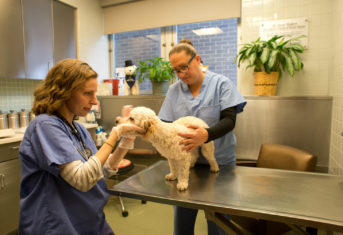Influenza in Dogs and Cats: What You Need to Know

Influenza in Dogs and Cats: What You Need to Know
In August, the New York Times warned of a “twindemic”: a seasonal influenza superimposed over the ongoing coronavirus pandemic. Doctors, local governments and the Centers for Disease Control all urged Americans to get a flu shot to prevent a twindemic. Then, around Christmas, the Times published another article indicating the twindemic had not materialized as predicted, probably because interventions designed to control the coronavirus also limit the spread of influenza viruses. Since flu seems to be less of a concern for humans this year, should we worry about flu in our canine and feline family members?
Canine Influenza: A Year-Round Concern
Dogs have their own flu viruses, very different from human flu viruses. Firstly, flu is not seasonal in dogs and an outbreak can happen any time of year. Strains of flu viruses are designated based on viral surface proteins called hemagglutinin and neuraminidase and named by combining the type of H protein with the type of N protein. The flu viruses responsible for human flu season are typically hemagglutinin 1 neuraminidase 1 (H1N1) and H3N2. The first dog flu virus was identified in 2005 as an H3N8 virus spread from horses to greyhounds. Since then, two more strains of canine flu viruses have been discovered – H3N2 and H5N2. H3N2 was discovered in 2006, originating in birds in Korea and spread to North America by imported dogs. (This is not the same H3N2 virus seen in human seasonal flu.) The H5N2 flu virus was identified in China in 2009, but does not appear to have made its way to the United States.
Dogs with the flu have upper respiratory signs, including coughing, sneezing, runny eyes and fever. Influenza viruses are just one cause of the kennel cough syndrome. Just like in people, canine flu virus spreads through the cough and sneeze of an infected dog. For dogs that mingle with other dogs in day care, dog parks and boarding kennels, vaccines are available against both H3N8 and H3N2 flu viruses.
Feline Influenza: A Misnomer
Cats do not have their own influenza virus despite the fact that upper respiratory infections are very common in cats. Some cat owners and veterinarians may refer for feline flu, but that is a misnomer. Most upper respiratory infections in cats are caused by the feline herpesvirus or the feline calicivirus. Some less common causes include mycoplasma, bordetella and chlamydia. The core cat vaccine known as FVRCP protects against herpesvirus and calicivirus.
Human to Animal Flu Transmission?
We know that, in rare instances, people can infect their pet with SARS-CoV-2, the viruses that causes COVID-19 in humans. The same is probably true for human influenza virus. There are rare reports of people giving the flu to their cat, dog or ferret. You will not like what I say next, but if you are sick, be sure to quarantine yourself away from all family members, including the furry ones. It will help avoid a pet and human twindemic in your own home!



































